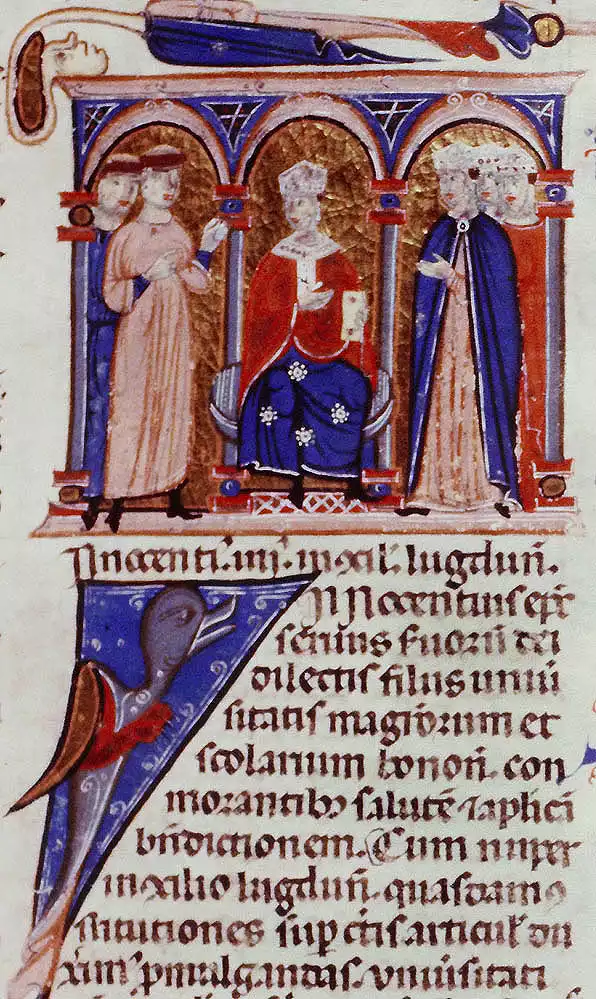
The First Council of Lyon in 1245 was a pivotal moment in the epic struggle between secular rulers and papal authority in medieval Europe. Occurring at a time when Pope Innocent IV was threatened by Holy Roman Emperor Frederick II, the council saw the pope wield the Church’s power to fulminate against temporal authority.
Assembling hundreds of prelates in Lyon, France, far from Frederick’s reach, Innocent IV issued a stunning decree – the excommunication and deposition of the formidable emperor. It was a drastic act with enormous repercussions, demonstrating the medieval papacy’s willingness to confront secular rulers no matter how powerful.
The council also set a new crusade under King Louis IX of France to reconquer the Holy Land from Muslim control. And it passed important Church reforms on issues like clergy behavior and taxation. But its brazen move against Emperor Frederick II is what cemented the First Council of Lyon as one of the most audacious church gatherings of the Middle Ages.
Innocent IV Excommunicates an Emperor
The epic clash between Pope Innocent IV and Holy Roman Emperor Frederick II had been brewing for years before the fateful First Council of Lyon convened in 1245. Frederick had long defied the papacy, refusing to cede control of lands in Italy and even delaying his promise to embark on crusade to the Holy Land. By 1244, Innocent IV had fled Rome as Frederick’s forces approached, finding refuge in Lyon under the protection of the French king.
Desperate to assert papal authority against this formidable foe, Innocent summoned a council of bishops and nobles to Lyon late that year. It was a calculated gamble, assembling Innocent’s allies far from the emperor’s reach. Yet as prelates streamed into the city along the Rhône River in June 1245, some still doubted the pope’s audacious plan could succeed.
In solemn ceremonies at Lyon’s Gothic cathedral, Innocent opened the council by condemning Frederick as no better than a faithless Saracen. He accused the emperor of violating oaths to the papacy, oppressing Sicilian clergy, and brutally suppressing rebels against his rule. Rumors even swirled of Frederick’s supposed heresy and correspondence with the sultan of Egypt. It was a litany of charges deliberately framed to justify Frederick’s excommunication.
Yet the emperor’s ambassador Thaddaeus of Suessa defiantly defended his master at the following council sessions. He questioned the process whereby one man, the pope, could sit in judgment over the reputed Vicar of Christ on Earth. Undeterred, the vengeful pontiff pressed ahead, winning over the conciliar fathers.
On July 17, 1245, Innocent solemnly proclaimed Frederick’s excommunication and deposition, stripping him of title and authority. Over 150 bishops affixed their seals to the fateful parchment as enthroned cardinals looked on. Christendom held its breath at this attack upon imperial majesty from the successor of St. Peter.
Innocent’s dramatic victory at Lyon was a milestone for papal supremacy, demonstrating the pope could bring even the mightiest ruler to heel. Although Frederick would defy his sentence for years after, the precedent was set. Ironically Innocent himself scarcely survived to savor his triumph, perishing unexpectedly mere months later.
The political earthquake unleashed at Lyon still resonates today. Historians debate whether Innocent’s startling assertion of authority saved Europe from imperial despotism, or imposed a papal dictatorship denying sovereign legitimacy. Eight centuries on, Holy Roman Emperor Frederick II remains both revered and reviled—an enduring legacy of the provocative First Council of Lyon.
The First Council of Lyon’s dramatic confrontation between Pope Innocent IV and Emperor Frederick II marked a pivotal moment for papal authority. By daring to depose this formidable ruler, Innocent demonstrated that no secular leader, however powerful, was beyond the Church’s reach. His vigorous assertion of supremacy came to define the medieval papacy at its apex. Ironically, Innocent scarcely survived to see the long-term impact of his audacious gambit, but the echoes of that fateful clash still resound eight centuries later.
References
Lunt, W. E. “The Sources for the First Council of Lyons, 1245.” The English Historical Review, vol. 33, no. 129, Jan. 1918, pp. 72-78. Oxford University Press. Accessed 7 Feb. 2024.
Morris, Colin. The Papal Monarchy: The Western Church from 1050 to 1250. Oxford University Press, 1991.
Pennington, Kenneth. Pope and Bishops: The Papal Monarchy in the Twelfth and Thirteenth Centuries. University of Pennsylvania Press, 1984.
Robinson, I.S. The Papacy 1073–1198: Continuity and Innovation. Cambridge University Press, 1990.
